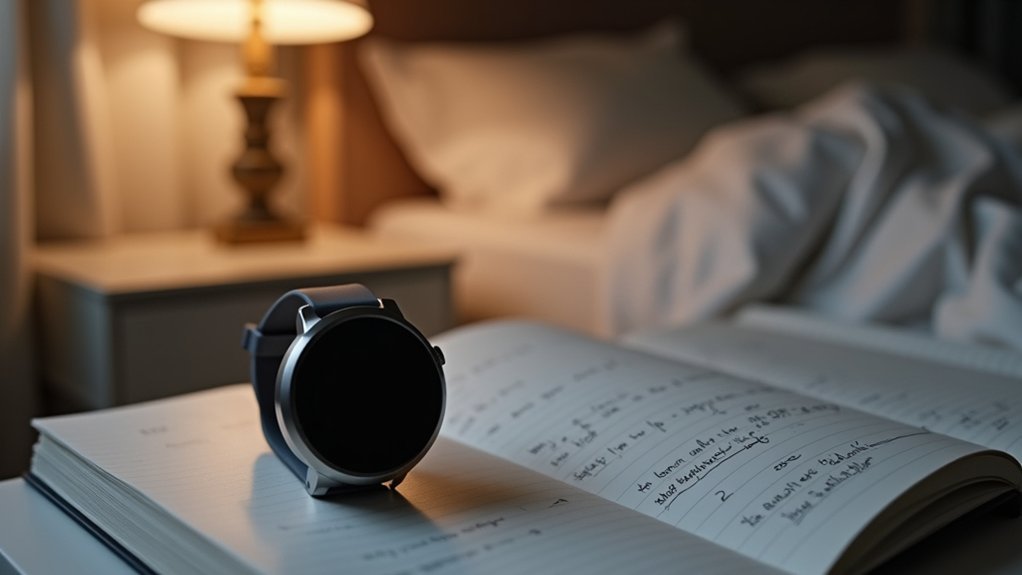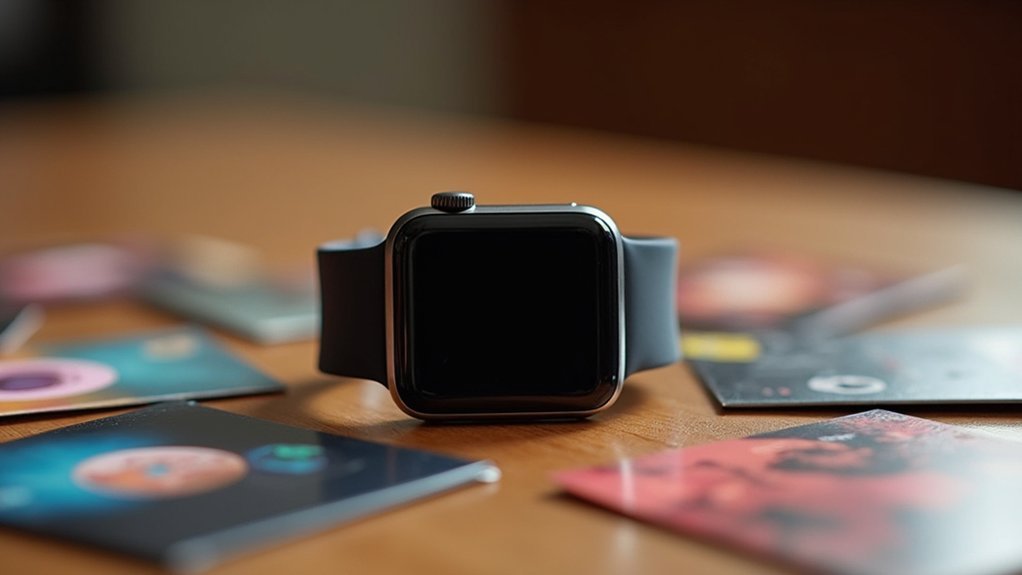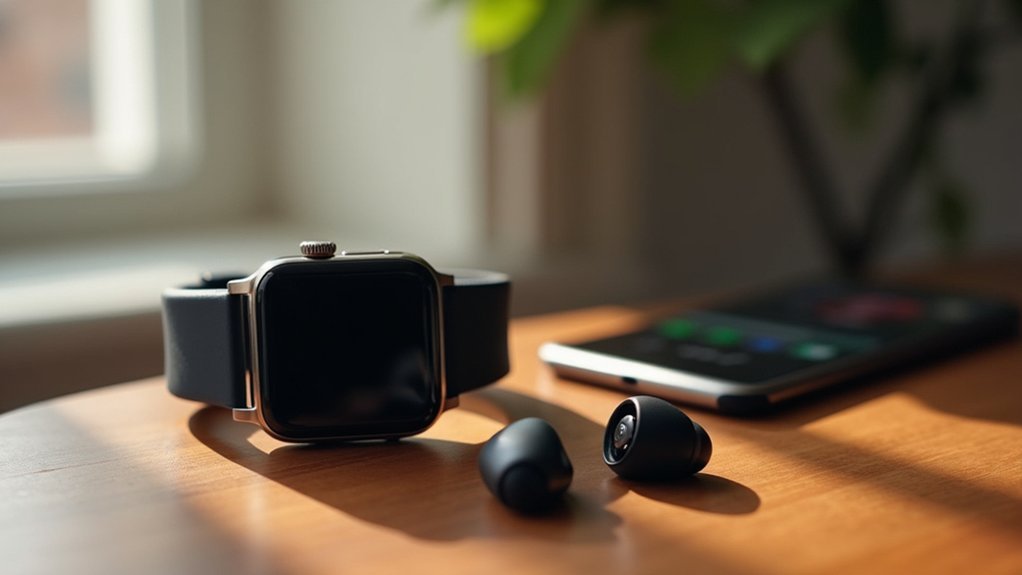Your fitness wearable’s sleep tracking reveals seven key insights: devices achieve 95%+ sensitivity for detecting sleep but struggle with wake detection at only 68.6% accuracy. Sleep stage classification remains limited at 50-70% precision, with most wearables overestimating total sleep time by 7-67 minutes. Multi-sensor devices combining heart rate, temperature, and motion data perform better than motion-only trackers. One-third of users now track sleep regularly, driving a growing $4.4 billion market that’s transforming how we perceive our nightly rest patterns.
Sleep Vs Wake Detection Accuracy Across Major Wearable Brands

When it comes to distinguishing between sleep and wake states, the three major wearable brands—Oura Ring Gen3, Fitbit Sense 2, and Apple Watch Series 8—all demonstrate impressive sensitivity rates of 95% or higher compared to clinical polysomnography standards.
However, you’ll find significant differences in their wake detection capabilities. Oura Ring stands out with 68.6% wake detection sensitivity, substantially outperforming both Apple Watch and Fitbit. This means Oura’s better at identifying when you’re actually awake during sleep periods.
While Fitbit and Apple Watch show adequate sleep/wake classification, they tend to overestimate light sleep stages.
Your individual factors like BMI and apnea-hypopnea index can influence detection accuracy across all devices, though gender differences remain minimal. The Oura Ring Gen 4’s sleep staging algorithm has been validated to match polysomnography sleep lab tests for exceptional accuracy.
Sleep Stage Classification Challenges and Device Limitations
You’ll find that sleep stage classification accuracy varies dramatically between different wearable brands and even between models from the same manufacturer.
Your device’s sensor technology creates significant limitations – most wearables rely heavily on motion data and basic heart rate monitoring, which can’t capture the subtle physiological changes that distinguish light sleep from REM or deep sleep stages.
These technological constraints mean your wearable often defaults to classifying uncertain periods as light sleep, leading to consistently skewed sleep stage data. Consumer-grade devices typically achieve only 50%-70% accuracy in sleep stage identification due to their reliance on basic accelerometer and PPG sensor combinations.
Algorithm Accuracy Varies Widely
While sleep tracking devices promise thorough insights into your nightly rest, their algorithm accuracy varies dramatically across different brands and sleep stage classifications.
You’ll find that devices combining accelerometry with photoplethysmography achieve classification accuracies of just 65-75% for sleep stages.
Fitbit’s overall accuracy ranges between 86.5% and 88%, but you’ll notice significant variations across different sleep phases. Your REM sleep detection sits at 69-72% sensitivity, while light sleep performs better at 53.4-78%. Deep sleep detection remains particularly challenging for most wearables you’ll encounter.
WHOOP has improved its accuracy by over 7% through internal testing and outperforms competitors when compared to polysomnography.
However, you’ll still experience proportional bias in sleep efficiency measurements across most devices. Consumer devices typically overestimate shorter wake times and underestimate longer wake periods during the night.
Sensor Technology Limitations
These accuracy limitations stem largely from fundamental constraints in sensor technology itself.
Your wearable’s accelerometer can detect movement but can’t reliably differentiate between sleep stages. When you’re lying still while awake, motion-based devices misclassify these periods as sleep, reducing wake detection accuracy.
Even advanced wearables combining heart rate, breathing patterns, and skin temperature struggle with stage classification.
While these physiological sensors improve detection beyond simple motion tracking, they’re still indirect proxies affected by external factors like stress and fitness levels. Your device’s sensors operate at lower resolution and sampling rates compared to clinical polysomnography, limiting data quality.
Sleep stages produce subtle physiological changes that current consumer-grade sensors can’t distinguish precisely. Consumer devices estimate sleep based on measured inactivity rather than monitoring actual brain wave patterns that define true sleep states.
This explains why your device might conflate NREM stages or misclassify REM periods.
Common Overestimation and Underestimation Patterns in Sleep Data
Your sleep tracker’s data isn’t as accurate as you might think, with devices consistently making predictable errors in how they measure your sleep.
Most wearables overestimate your total sleep time by anywhere from 7 to 67 minutes, while also struggling to correctly identify which sleep stage you’re actually in. Despite these limitations, 78% of users find their sleep trackers helpful for understanding their sleep patterns.
You’ll find that your device often overestimates shorter light sleep periods but underestimates longer ones, creating a systematic bias that skews your sleep data.
Sleep Duration Overestimation
How accurate are those sleep hours your wearable reports each morning? You’re likely getting inflated numbers. Most wearables overestimate your total sleep time by significant margins, with Fitbit devices leading this trend by counting sedentary periods as sleep.
| Device Type | Overestimation Range | Common Issue |
|---|---|---|
| Fitbit Models | 7-67 minutes | Counts low-activity as sleep |
| WHOOP | Generally less than Fitbit | Poor wake detection (56% accuracy) |
| Garmin Vivosmart | Varies by model | Misclassifies light sleep segments |
| Withings Mat | Minimal overestimation | Underestimates sleep onset |
| General Wearables | Consistent overestimation | Movement-based detection flaws |
This overestimation stems from movement-based detection algorithms that interpret stillness as sleep, missing subtle wake episodes throughout the night. Current wearables achieve 86 to 89 percent accuracy for determining whether you’re asleep or awake overall.
Stage Detection Errors
Beyond inflated sleep duration numbers, wearables struggle with accurately identifying specific sleep stages throughout the night. Your device likely overestimates light sleep by misclassifying wake periods or REM episodes, creating inflated scores.
Meanwhile, REM sleep gets shortchanged due to its complex physiology that’s difficult to detect through movement and heart rate alone.
Common stage detection problems you’ll encounter:
- Light sleep inflation – Your wearable mistakes quiet wakefulness for light sleep stages
- Missing wake periods – Brief nighttime awakenings get misclassified as continued sleep
- REM underestimation – Complex REM physiology confuses motion-based sensors
- Smoothed shifts – Devices miss micro-arousals, creating unrealistically stable sleep profiles
Devices using multiple physiological signals perform better, but even top-rated wearables achieve only moderate agreement with clinical sleep studies. However, advanced wearables trained on polysomnography data have shown measurable improvements in sleep stage accuracy across all four sleep phases.
Device-Specific Performance Comparisons for Sleep Tracking
When evaluating sleep tracking devices, you’ll find significant performance variations across different brands and models, with each offering distinct strengths and trade-offs.
Whoop excels with 99.7% heart rate accuracy and 99% heart rate variability precision, making it ideal for recovery tracking.
Fitbit devices balance sensitivity and specificity well, with newer models like Sense 2 showing improved sleep stage detection.
Garmin devices detect nearly all sleep time but struggle with wake moments, creating high sensitivity but low specificity.
Polar offers the opposite pattern with lower sensitivity but better specificity.
Oura Ring 3 demonstrates enhanced accuracy compared to previous versions, while Eight Sleep’s integration with temperature control shows practical applications beyond basic tracking.
Apple Watch Series 8 delivers strong performance with its new sleep staging algorithm, showing consistent top-tier accuracy in sleep detection.
Consumer Adoption Rates and Behavioral Changes From Sleep Tracking
One-third of wearable device users now track their sleep regularly, reflecting sleep monitoring’s emergence as a core health metric alongside traditional fitness tracking.
You’re part of a rapidly growing market that’s projected to expand from 2.29% penetration in 2020 to 6.51% by 2029, with the sleep monitoring sector alone valued at $4.4 billion and growing at 17.7% annually.
Your adoption likely stems from increased awareness of sleep’s impact on wellness and the rising prevalence of sleep disorders.
Once you start tracking, you’ll probably modify your behaviors based on the insights:
- Adjusting bedtime routines by reducing pre-sleep screen time
- Prioritizing sleep as a key health and fitness goal
- Making lifestyle changes in diet and activity scheduling
- Improving sleep hygiene practices for better duration and consistency
The technology itself has evolved significantly, with modern fitness trackers offering comprehensive monitoring beyond basic step counting, including advanced features like stress levels, blood oxygen saturation, and smartphone integration across both iOS and Android platforms.
Heart Rate and Physiological Data Integration for Sleep Analysis
How effectively can your wearable device translate the rhythm of your heartbeat into meaningful sleep insights? While your device captures minute-by-minute heart rate averages throughout the night, it can’t access the precise beat-to-beat data that researchers prefer.
Your wearable measures heart rate variability to indirectly assess sleep stages and quality, but accuracy remains questionable without polysomnography validation.
Modern devices capture diverse bio-signals including skin conductance and temperature alongside heart rate data. However, you’ll find these devices oversimplify complex physiological responses and struggle with accurate quantification. Simple actions like swallowing or movement can introduce measurement artifacts that distort the data your device collects during sleep.
Your wearable’s continuous monitoring provides valuable all-encompassing data, yet integrating multiple physiological signals presents significant challenges due to human biology’s inherent complexity and variability.
Multi-Sensor Approaches to Enhance Sleep Monitoring Accuracy

While single-sensor devices provide basic sleep metrics, you’ll discover that multi-sensor wearables offer a quantum leap in monitoring accuracy by combining accelerometers, photoplethysmography sensors, skin temperature monitors, and galvanic skin response detectors into one all-inclusive system.
These advanced devices overcome motion-only trackers’ limitations by distinguishing between quiet wakefulness and actual sleep through multiple physiological signals. You’re getting thorough data that captures sleep fragmentation, staging, and respiratory parameters in real-time. The home environment provides more representative sleep data compared to clinical laboratory settings, making these devices particularly valuable for personal sleep assessment.
Multi-sensor wearables transcend basic motion tracking by analyzing comprehensive physiological data to accurately differentiate between restful wakefulness and genuine sleep states.
- Enhanced disorder detection – Identify complex sleep disruptions like sleep apnea through oxygen saturation monitoring
- Improved clinical reliability – FDA-cleared multi-sensor devices provide validated measurements for medical research
- 24/7 continuous monitoring – Collect longitudinal data supporting better understanding of sleep’s health impact
- Superior accuracy – Combine complementary data streams rather than relying on movement alone
Frequently Asked Questions
How Long Should I Wear My Sleep Tracker Before the Data Becomes Reliable?
You should wear your sleep tracker for at least one week to get reliable data. For very good reliability, wear it for 10-14 nights to establish consistent patterns and meaningful insights.
Can Sleep Trackers Detect Sleep Disorders Like Sleep Apnea or Insomnia?
You can’t rely on sleep trackers for definitive sleep disorder diagnosis. They’ll detect potential sleep apnea or insomnia patterns through movement and heart rate monitoring, but you’ll need professional sleep studies for accurate clinical diagnosis.
Do Sleep Trackers Work Accurately for People With Irregular Sleep Schedules?
Sleep trackers aren’t as accurate if you’ve got irregular sleep schedules. They’re designed for typical routines, so napping, shift work, or frequent schedule changes can confuse their algorithms and reduce reliability.
Should I Make Medical Decisions Based on My Sleep Tracker Data?
You shouldn’t make medical decisions based solely on your sleep tracker data. These devices lack validated clinical guidelines and can misclassify sleep states. Use them to supplement, not replace, professional sleep assessments.
How Do Sleep Trackers Perform for Side Sleepers Versus Back Sleepers?
Side sleepers typically get more accurate tracking since you’ll have clearer movement patterns for devices to detect. Back sleepers may experience less accurate data due to subtler movements and fewer position changes during sleep.
In Summary
You’ll find that sleep tracking technology has come far, but it’s not perfect yet. Your device might miss brief awakenings or misclassify sleep stages, but it’s still giving you valuable insights into your sleep patterns. Don’t rely solely on the data – use it as a guide alongside how you actually feel. The multi-sensor approach is improving accuracy, so you’ll see better tracking as technology advances.





Leave a Reply